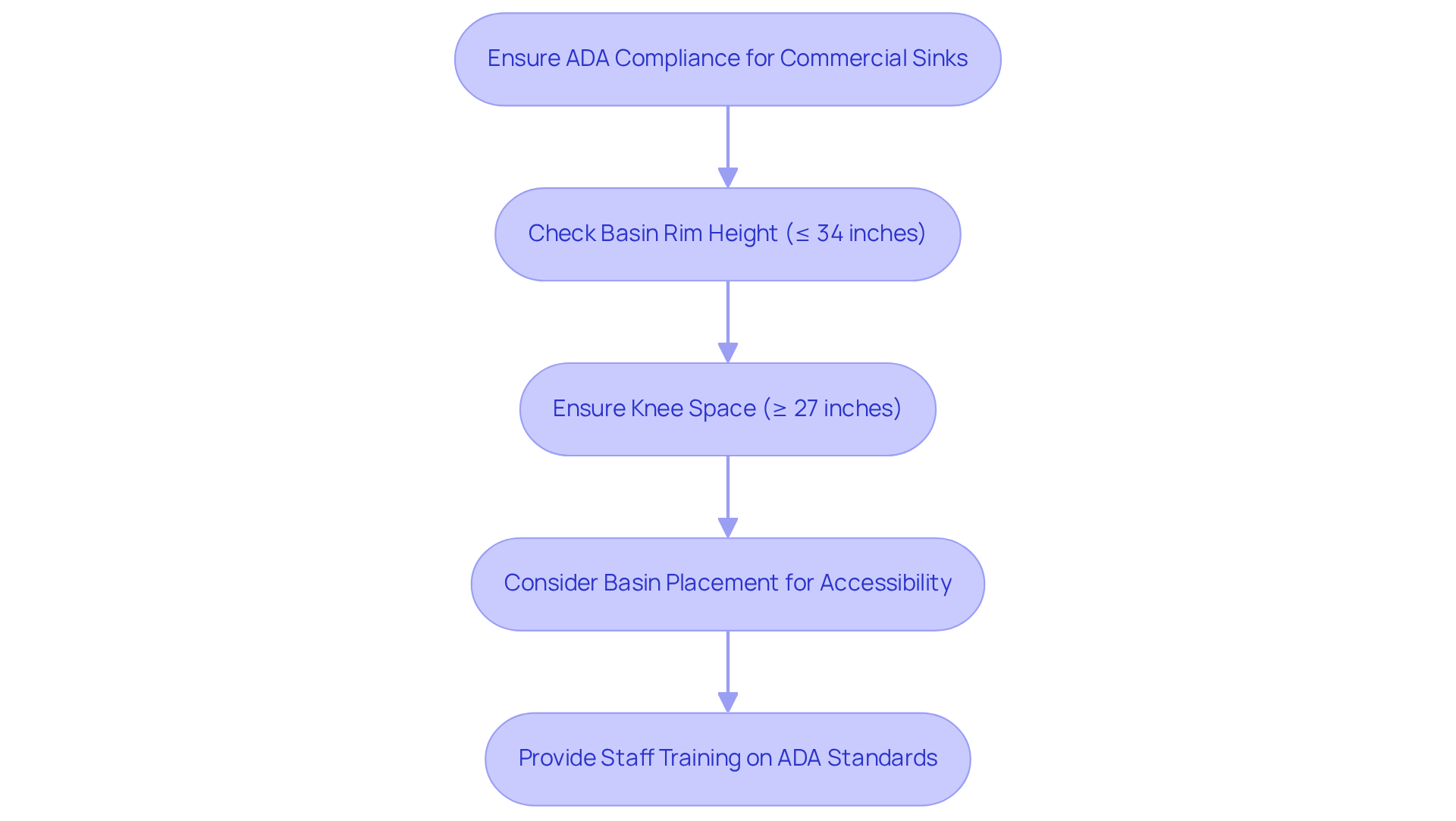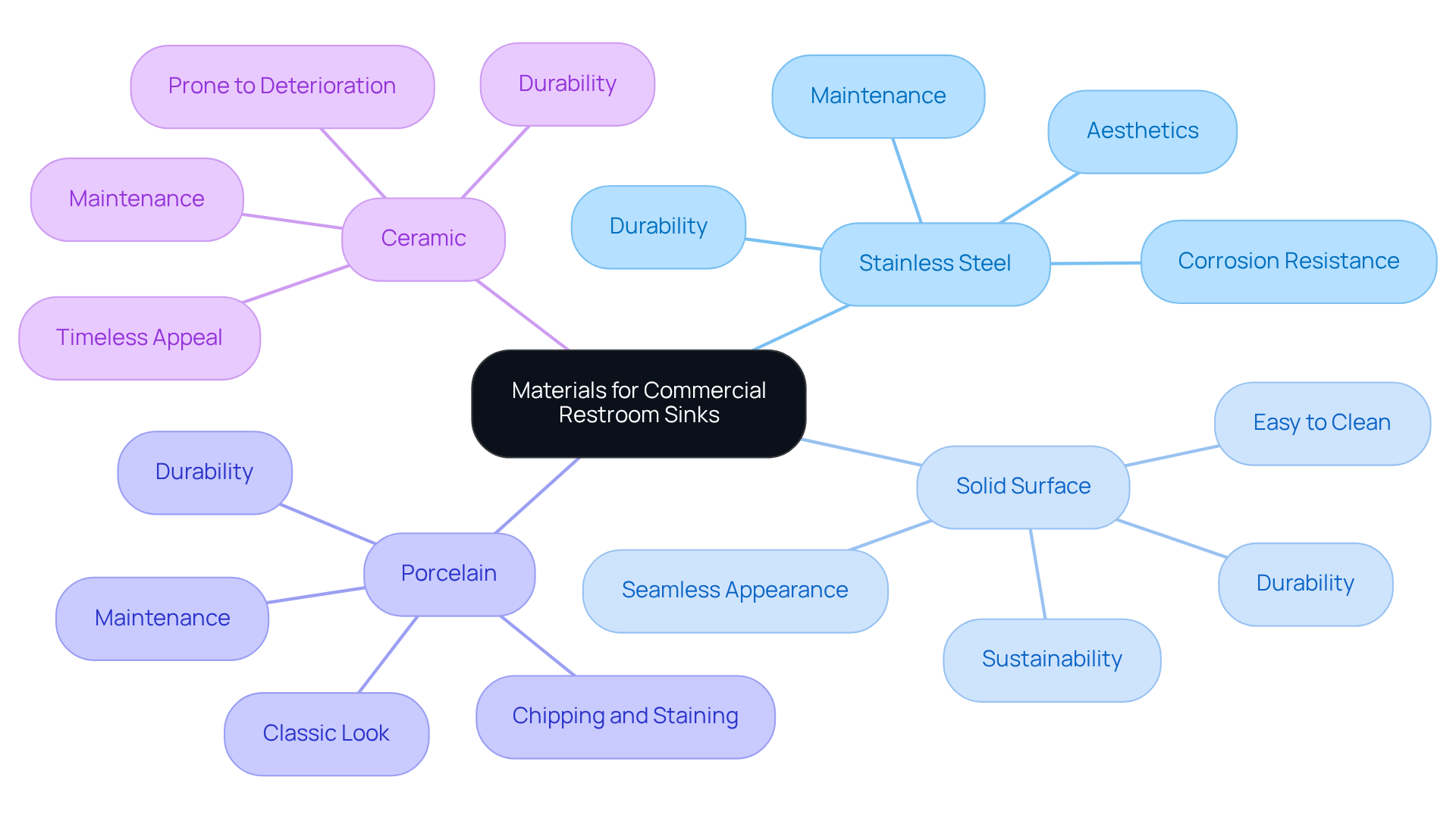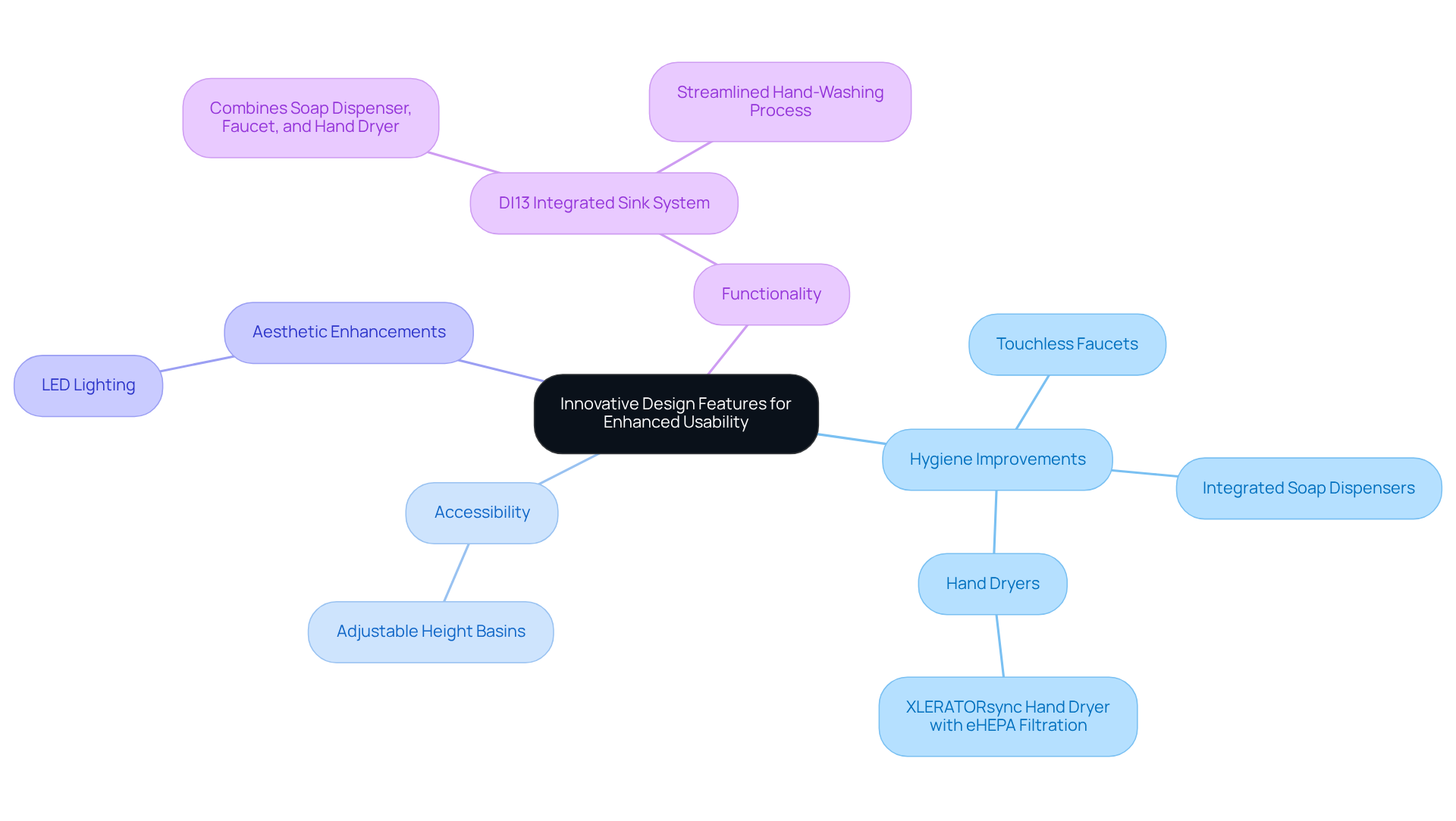Overview
Choosing commercial restroom sinks demands careful consideration of several key factors.
- First and foremost, prioritizing quality and compliance with regulations is essential.
- Selecting appropriate materials not only ensures durability but also enhances aesthetics.
- Incorporating innovative design features significantly improves usability.
- Furthermore, adherence to standards such as the ADA, the selection of robust materials like stainless steel, and the integration of features such as touchless faucets collectively guarantee that the sinks remain functional, accessible, and visually appealing, particularly in high-traffic environments.
Introduction
Selecting the right commercial restroom sinks transcends mere functionality; it constitutes a pivotal decision that profoundly influences user experience and adherence to essential regulations. By prioritizing quality, materials, and innovative design, facilities can cultivate environments that are not only durable and visually appealing but also accessible to all individuals.
Nevertheless, with an abundance of options at hand, how can decision-makers ensure that their selected sinks fulfill both practical requirements and regulatory standards? This article explores four fundamental considerations that will assist decision-makers in navigating the intricacies of restroom sink selection, ultimately enhancing usability and satisfaction in high-traffic environments.
Prioritize Quality and Compliance in Sink Selection
When selecting commercial restroom sinks, it is paramount to prioritize quality by choosing products from reputable manufacturers known for their craftsmanship. Choose commercial restroom sinks that comply with local building codes and health regulations, ensuring they are suitable for high-traffic environments.
For instance, commercial restroom sinks constructed from robust materials, such as stainless steel or solid surface, provide enhanced durability and ease of maintenance. Furthermore, consider the warranty and service options provided by the manufacturer, as these can serve as indicators of product reliability.
Adhering to standards like NSF and ADA is essential, guaranteeing that basins are secure and accessible for all individuals, including those with disabilities. A case study involving The Splash Lab's installations in high-traffic venues, such as the projects for Padel Haus in New York and Lacuna Space in California, illustrates how quality and compliance significantly enhance user experience and satisfaction.
By merging innovative design with practical usability, The Splash Lab demonstrates that well-crafted basins not only meet functional requirements but also elevate the overall bathroom experience. Moreover, it is crucial to verify that commercial restroom sinks are no higher than 34 inches from the ground and provide a minimum of 27 inches of toe clearance underneath, as these specifications are vital for ADA compliance.
Addressing common pitfalls, such as ensuring fixtures are positioned within reach, can further enhance restroom usability.

Understand ADA Requirements for Commercial Sinks
To ensure adherence to the Americans with Disabilities Act (ADA), it is imperative that commercial basins are designed with specific height and clearance requirements. The basin rim must not exceed 34 inches from the ground, and there should be a minimum of 27 inches of knee space below, accommodating individuals in wheelchairs. Furthermore, the basin's placement is crucial to facilitate easy access and usability. Integrating these features not only meets legal requirements but also enhances the overall bathroom experience for all users.
For instance, The Splash Lab's projects have effectively incorporated ADA-compliant basins, illustrating how thoughtful design can create accessible and practical environments.
Regular training for staff on ADA compliance is essential to ensure that facilities consistently meet these standards.

Choose Appropriate Materials for Durability and Aesthetics
Choosing the appropriate materials for commercial restroom sinks is essential for achieving both durability and visual appeal. Stainless steel is particularly noteworthy for its strength and corrosion resistance, establishing itself as a reliable choice for high-traffic environments. Solid surface materials not only provide a seamless appearance but are also easy to clean, thereby enhancing the overall restroom experience. While porcelain and ceramic basins are often preferred for their classic look and durability, they typically demand more upkeep to prevent chipping and staining. In contrast, solid surface materials generally require less maintenance than ceramic basins, which can be prone to deterioration over time.
When selecting materials, it is crucial to align with the overall aesthetic of the facility, ensuring that the commercial restroom sinks complement other fixtures. The Splash Lab's application of solid surface materials across diverse projects exemplifies how these choices can yield visually striking and functional bathroom environments. Furthermore, prioritizing sustainable materials not only resonates with contemporary aesthetics but also addresses environmental concerns; research indicates that 70% of consumers factor sustainability into their purchasing decisions. By harmonizing durability with aesthetics, designers can create spaces that are both practical and inviting. As Brent Otsuka, Manager of Interior Design at Fentress Architects, articulates, 'The Splash Lab has well-crafted and beautifully designed products. I consistently approach them first to create a holistically crafted facility, underscoring the importance of careful material selection in bathroom planning.

Incorporate Innovative Design Features for Enhanced Usability
Incorporating innovative design features into commercial restroom sinks greatly improves usability and customer satisfaction. Touchless faucets are pivotal in reducing the spread of germs, thereby improving hygiene. These faucets not only minimize contact but also offer adjustable flow rates, accommodating various individual needs. Furthermore, integrated soap dispensers and hand dryers streamline the washing process, making it both efficient and hygienic. The D|13 Integrated Sink System exemplifies this innovation by integrating commercial restroom sinks with a soap dispenser, faucet, and XLERATORsync hand dryer that is equipped with eHEPA Filtration, which removes 99.999% of viruses and 99.97% of bacteria from the airstream. This enhancement elevates hygiene and safety for individuals, and the system has been acknowledged for its significant impact on bathroom functionality.
Adjustable height basins, such as commercial restroom sinks, further improve accessibility, accommodating individuals of varying heights and abilities, thereby promoting inclusivity in facility layout. The adaptable styling choices for commercial restroom sinks, including hue, form, and measurements, empower architects to construct sophisticated public facilities that fulfill specific project needs. In addition, aesthetic elements such as LED lighting around sinks can create a more inviting atmosphere, encouraging cleanliness and proper usage. The Splash Lab has effectively incorporated these features in projects such as Padel Haus and Lacuna Space, demonstrating how contemporary technology and considerate planning can transform bathroom environments into spaces that emphasize both functionality and user experience. As John Freitas, General Manager of D|13 Group, noted, 'We’re proud to be able to give architects a new option for integrating commercial restroom sinks that are both aesthetically pleasing and highly functional into restroom designs.

Conclusion
Selecting the right commercial restroom sinks requires a careful balance of quality, compliance, and innovative design features. Prioritizing these elements ensures facilities not only meet regulatory standards but also provide a positive user experience. By focusing on reputable manufacturers and durable materials, decision-makers can create restrooms that are both functional and aesthetically pleasing.
Key insights from the discussion underscore the importance of adhering to ADA requirements, choosing appropriate materials, and incorporating features that enhance usability. High-quality sinks made from materials like stainless steel or solid surfaces withstand heavy use and contribute to the overall look and feel of the restroom. Furthermore, integrating innovative technologies, such as touchless faucets and adjustable height basins, significantly improves hygiene and accessibility for all users.
Ultimately, the selection of commercial restroom sinks should reflect a commitment to quality and user satisfaction. By considering these key factors, businesses can transform their restroom environments into welcoming spaces that prioritize both functionality and design. Emphasizing these best practices will enhance the restroom experience and demonstrate a dedication to providing accessible and efficient facilities for everyone.
Frequently Asked Questions
Why is it important to prioritize quality when selecting commercial restroom sinks?
Prioritizing quality is essential to ensure the sinks are durable and reliable, especially in high-traffic environments. Choosing products from reputable manufacturers known for their craftsmanship helps guarantee this quality.
What materials are recommended for commercial restroom sinks?
Recommended materials include stainless steel and solid surface, as they provide enhanced durability and ease of maintenance.
What compliance standards should commercial restroom sinks meet?
Commercial restroom sinks should comply with local building codes and health regulations, as well as standards like NSF (National Sanitation Foundation) and ADA (Americans with Disabilities Act), ensuring safety and accessibility for all individuals, including those with disabilities.
What are some important dimensions to consider for ADA compliance?
For ADA compliance, sinks should be no higher than 34 inches from the ground and provide a minimum of 27 inches of toe clearance underneath.
How can the warranty and service options from manufacturers indicate product reliability?
A good warranty and service options from manufacturers can serve as indicators of product reliability, suggesting that the manufacturer stands behind their product quality.
Can you provide an example of how quality and compliance enhance user experience?
A case study involving The Splash Lab's installations in venues like Padel Haus in New York and Lacuna Space in California shows that focusing on quality and compliance significantly enhances user experience and satisfaction.
What common pitfalls should be avoided when selecting commercial restroom sinks?
Common pitfalls include ensuring that fixtures are positioned within reach, which can further enhance restroom usability.




